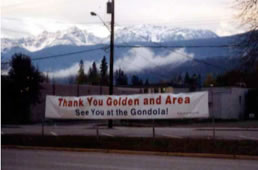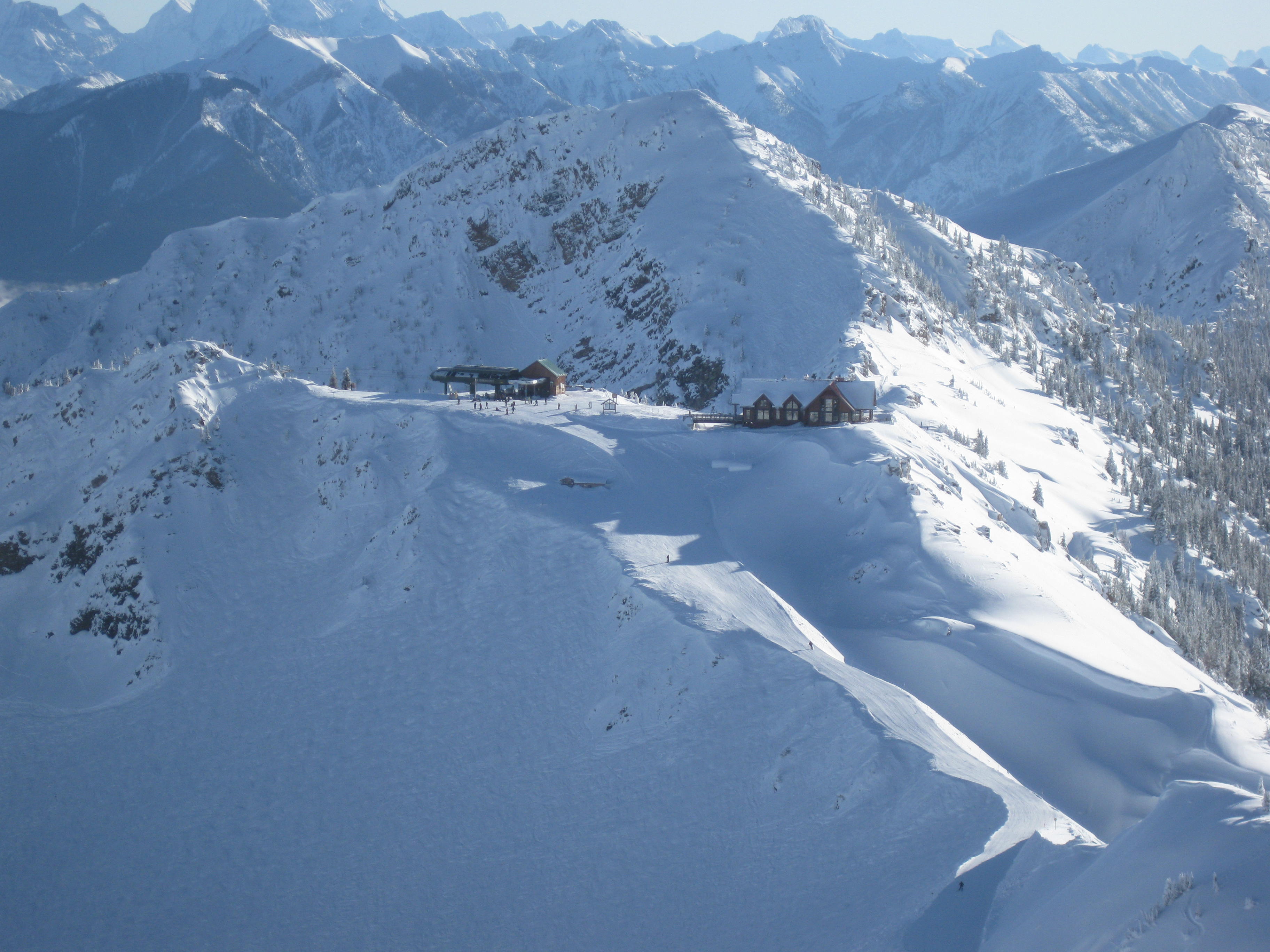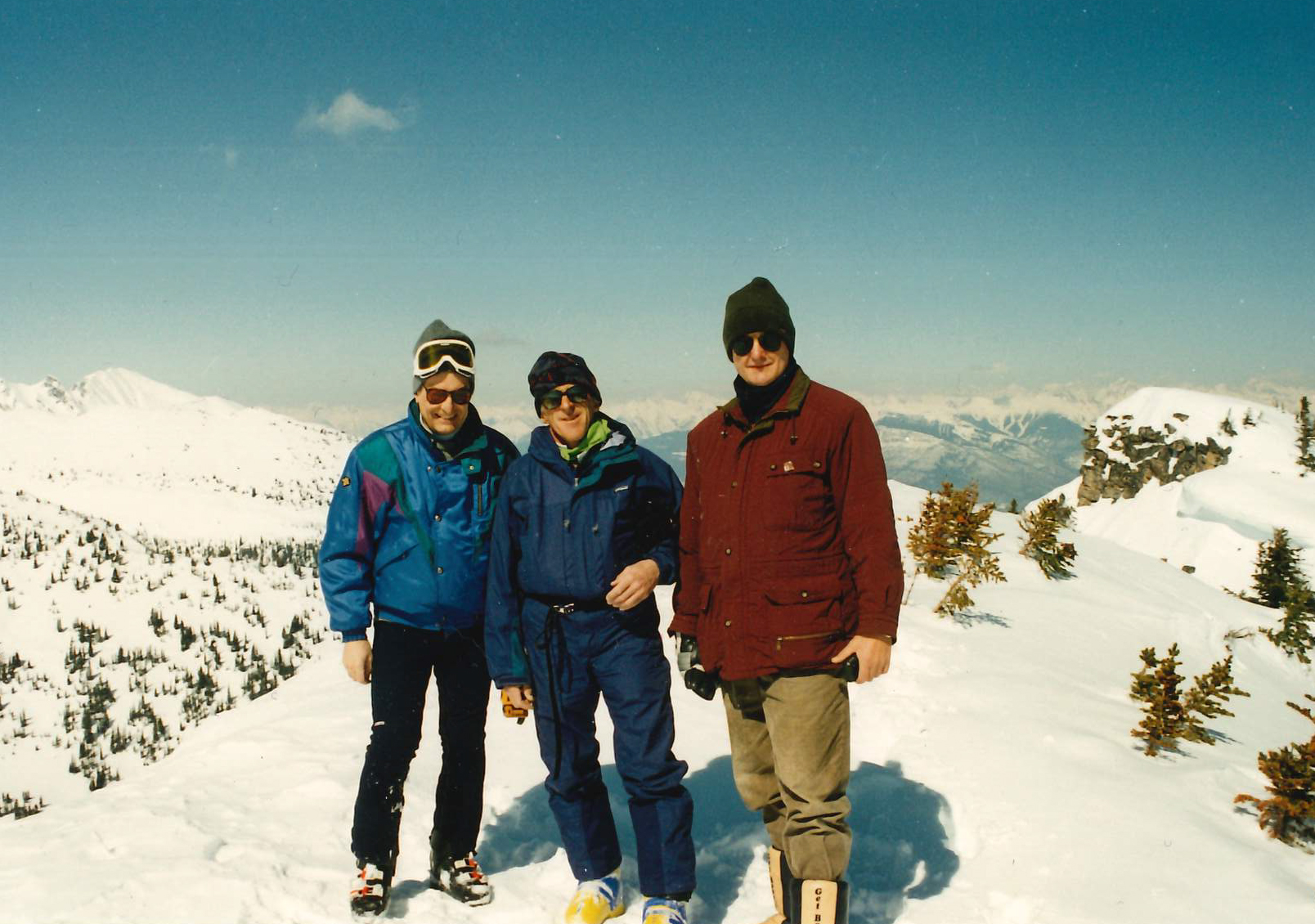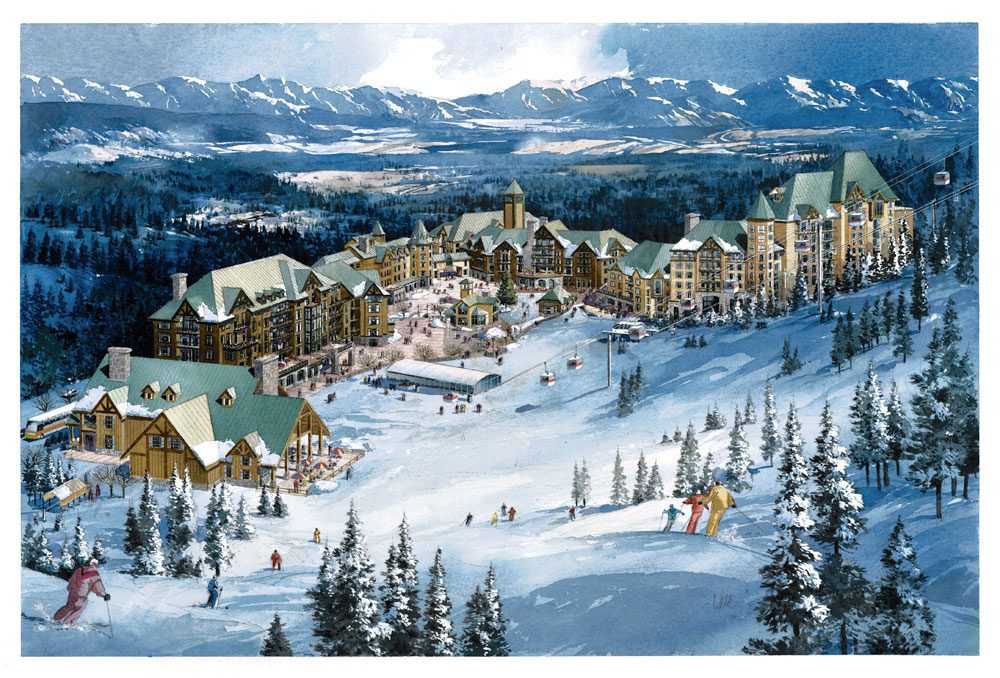The Birth of an Iconic Resort: The Story and Events that led to the Referendum of September 20, 1997 that gave Birth to KHMR
Jim Chamberlain was a lawyer and investment advisor from New York who had brought some wealthy Americans into the Jumbo Glacier Resort (JGR) project after its initial investor, Nikken Canada Holdings Ltd., withdrew from the project in 1993. He had been introduced by a retired developer and former client of Oberto Oberti’s in Vancouver who was an admirer of the JGR project and was disappointed by the exit by Nikken.
Jim and his American friends and investors had become frustrated by the rising controversies and changes of direction in the approval process of the JGR project. At the time, while the commissioner of the Commission on Resources and the Environment had recommended that the project proceed under existing policy, the project was instead transitioned by Minister’s order into the then newly enacted and untested Environmental Assessment Act process. Provincial staff and Ministers promised that the EA Act process would be completed in two years, but Oberto expressed to Jim that he feared it would take much longer, and that it would multiply the costs and the length of the approval process.

Pheidias’ banner in Golden, thanking the people of Golden. October 1997.
Oberto instead suggested that the American investors may find better cooperation from government by pursuing infrastructure projects. Infrastructure projects seemed to have greater favour at the time and were perceived by government staff to be more clearly in the public interest than tourism projects.
The upgrading of the Lions Gate Bridge in Vancouver was an example of such a needed infrastructure project. The bridge desperately needed to be rebuilt and upgraded for safety and greater traffic capacity. Oberto had been involved with the same bridge issues when he was an employee of Phillips Barratt in the early 1970s, just before he moved on to the Dunhill Development Corporation.
Jim Chamberlain thought that it was a good idea to look at a bridge project and that his investment contacts would like it. In June 1995, he arranged that Oberto meet with Ballast Nedam (the main contractor in the construction of the Confederation Bridge between Prince Edward Island and New Brunswick) at their office in Amsterdam. Jim had prepared an agenda that included a presentation on the JGR project, which had an approval process under way, but encouraged Oberto to talk about infrastructure projects and especially of the Lions Gate Bridge.
The meeting in Amsterdam went very well. Oberto met with director Piet Vet and his assistant Arijan van Vuure, and he was asked to prepare information and to plan government meetings to define a project proposal. By September 1995, Ballast Nedam committed itself to find a project in B.C. and became a client of Oberto and his Pheidias Group of companies. This was despite the fact that Piet Vet had had a disagreement with Jim Chamberlain regarding an unrelated project in the Caribbean Islands, and Ballast Nedam did not continue conversations with Jim Chamberlain.
Earlier in the same year – 1995 – Oberto and his planning associate, Alan Artibise (formerly the head of the UBC School of Planning), attended an economic development forum in Nelson B.C. and happened to sit at a dinner table across from Mayor Fred Demmon of the Town of Golden and the Administrator of the town.
The Mayor spoke of the supportive mood in Golden for ski resort development and of the desire to expand the existing Whitetooth ski hill. He suggested that the proponent of the JGR project should come to Golden. Oberto and Alan noted that investors in a project created to provide glacier access for sightseeing and year-round skiing were not likely to give up their project to expand Whitetooth. Nevertheless, the conversation remained in Oberto’s mind.
In late 1995 and early 1996 Ballast Nedam director Piet Vet and his assistant Arijan Van Vuure made several trips to Vancouver. Oberto met with them again in Amsterdam and Oberto and Alan were invited to visit the impressive construction staging site in PEI where Ballast Nedam was building the Confederation Bridge. The site included a colossal dock where the Svanen was located. Svanen was a sophisticated and huge crane ship used to transport and place prefabricated bridge components with great precision. The visit to PEI left no doubts in Oberto and Alan’s minds regarding the impressive capabilities of Ballast Nedam.
Many meetings with government staff and Ministers followed. Oberto and Piet Vet had dinner with the Premier discussing bridge prospects, and provincial government and staff tried very hard to find a project for Ballast Nedam. However, bridge projects outside Vancouver were not economical and in Greater Vancouver, local governments would not support new or larger crossings. The prospects for major bridge work in B.C. began to wane.
Piet Vet and one of his other assistants, Isaac Kalisvart, had just completed a Grand Hyatt in Aruba and Whistler was in great need of a hotel of that calibre, as the only major hotel at the time was the Canadian Pacific Chateau Whistler. Oberto met with Arijan van Vuure in Whistler in March 1996. Following his visit, Ballast Nedam commissioned a study to develop a Grand Hyatt with a new village at Whistler’s Creekside.
A draft agreement with Charles Young and Frank Barker of Whistler Mountain Ski Corporation was prepared for the site acquisition. There was preliminary design work done and many meetings with the vendor’s project manager Howard Nemtin. In November 1996 Piet Vet flew in from Amsterdam to conclude the deal. At the meeting, Charles Young and Frank Barker explained that they no longer controlled the company and they were merging with Blackcomb’s controlling company (Intrawest) so they could not close the deal.
The meeting was followed by a meeting with Peter Finley, the lawyer of Ballast Nedam, at Fasken Martineau DuMoulin in Vancouver. Piet Vet was extremely unhappy, but expressed the opinion that Ballast Nedam would not begin working in Western Canada by starting with litigations against Whistler Mountain Ski Corporation and /or Intrawest.
The meeting was attended also by Alan Artibise and Brian Wills. Oberto did not want to see Piet Vet going back to Amsterdam empty-handed after almost two years of work to create a project for Ballast Nedam, at considerable cost.
Oberto launched the idea that if Whistler was closed to Ballast Nedam, it could do the Grand Hyatt at Golden’s Whitetooth, near the National Parks. Oberto explained that there was a great need of a major hotel at the doors of the National Parks, and the community seemed supportive, but Peter, Alan and Brian suggested that Oberto should give up.
Piet Vet departed disappointed. Oberto and Brian met with Dan Jarvis at Intrawest but were told that Intrawest did not need Ballast Nedam, and it would develop Creekside by itself.
Oberto decided to go to Golden and see if the Mayor and Council would still be interested in a tourism project expanding Whitetooth. The idea was to put Golden on the map with a major lift to the mountaintop with a hotel at its base.
Oberto travelled to Golden with some concern regarding the potential reception by the Mayor and Council and the community. In fact, earlier in the year, in February 1996, the East Kootenay Environmental Society held its AGM in Golden where a motion was passed prohibiting the renewal of the membership of Oberto’s company because it was the project manager in the approval process of the Jumbo Glacier Resort (JGR) project. It was an illegal motion, but Oberto did not take issue with it to avoid more controversies.
On arriving in Golden in December 2016, Oberto had a certain apprehension that the local reception of a new mountain resort project might be difficult. Instead, the new Mayor and Council welcomed Oberto warmly, praising his design and studies for the JGR project and welcoming the idea of a project that would put Golden on the tourism map, giving access to the mountain top and creating quality tourism beds.
Oberto also met with the Economic Development Officer, Lee Malleau, with the local Ski Society President, Flec Demmon, and its past president Mike MacNight and his wife Merle, and with Rudi Gertsch, the owner and operator of Purcell Heli-ski. It was a case of instant friendship and support.
Oberto reported of the success of the trip to Ballast Nedam and outlined the opportunity. This was met with some support and a preliminary study was commissioned.
Oberto quickly assembled his planning team and explored Whitetooth, meeting its operator, Fred Briggs, and mapping mountaintop locations and ski runs with Rudi Gertsch’s assistance.
The concept was to build a gondola lift to the mountaintop and a major hotel (the Grand Hyatt) at the base. This would put Golden on the tourist map.
Local supporters were eager to provide information and advice. Rudi Gertsch was particularly supportive, with only one request, and that was to exclude from the project one of his favourite ski runs, which the planning team gladly did. Another important piece of advice was to avoid compromising the West Bench and its wildlife connectivity with spread-out development proposals.
The preliminary study, including a small resort village tucked against the mountain and a gondola lift that provided spectacular vistas and opened up the whole ski potential of the mountain range, was completed by the end of February. This was the first time in North America that a bottom-to-top gondola lift had been proposed that reached a mountain peak, making it possible for visitors and skiers to see what lies beyond the crest of the mountain. The concept was that with a single gondola lift, it would be possible to provide access to a whole mountain for skiing while providing spectacular vistas.

Photo showing Purcell Heli-ski’s helicopter at the planned teahouse location (now the Eagle’s Eye Restaurant) in March 1997. Arijan Van Vuure asked that the picture be displayed prominently in the KHMR day lodge.
Photo showing Purcell Heli-ski’s helicopter at the planned teahouse location (now the Eagle’s Eye Restaurant) in March 1997. Arijan Van Vuure asked that the picture be displayed prominently in the KHMR day lodge.
The concept was reviewed with favour in Amsterdam and a joint trip to Golden was made near the end of March 1996. Rudi Gertsch offered to fly the group to the future gondola arrival point and future Eagle’s Eye Restaurant location free of charge. The picture of that helicopter landing at the mountaintop is still in the lobby at the day lodge at KHMR. It was on that occasion, on the mountain top, that Brian Wills, previously sceptical, told Arijan van Vuure that the project would work. The decision was made. I believe I still have the picture shaking hands with Rudi on the mountain top on that day.
Arijan went back to Amsterdam and from there confirmed that Ballast Nedam had commissioned the project to the Pheidias Group. A company was created to be the developer of the project as a 100% subsidiary of Ballast Nedam. Oberto was named director and president and Alan as director and secretary. The company’s name was proposed by Brian and it was chosen to be Golden Peaks Resort Ltd.
Oberto, Brian Wills and Piet Vet met the owners and the top management of Hyatt in Chicago and the interest for the participation of Hyatt in the project was confirmed. The Pritzker father and son planned a visit to Golden in July.
The project supporters and the Mayor and Council were enthusiastic and wanted to make sure that this project would not become engulfed in controversies like the JGR project only 100 km to the south.
The local MLA was Jim Doyle, who was also Minister of Forests, and he had become an opponent of the JGR project following a negative public meeting in Invermere organized by the EA Office in September 1995. However, Jim Doyle met with Oberto and offered support without hesitation for the project near Golden, his home town. The project was on Crown land under the jurisdiction of the Province and of the Regional District of Columbia Shuswap as a local government. The regional district’s office was in Salmon Arm, and while the planner of the regional district was not supportive, the Administrator and the directors were unanimously supportive.
The Mayor of Golden, Norm Macdonald, and the regional district director, Duane Crandall, were on opposite sides politically but decided to join forces to keep the approval process on track. The support of the Mayor and Council of the Town of Golden, despite the fact that the project was outside the Town’s boundary, was as important to the project as that of the regional district’s. A public information meeting on the project was held by joint initiative of the director, Duane Crandall and of the Mayor, Norm MacDonald.
The meeting was attended by some 80 people and Oberto recognized many of the JGR opponents who had come to meetings in Invermere. It was with considerable apprehension that Oberto heard that there would be a referendum regarding the project. This was unprecedented and not according to the Commercial Alpine Ski Policy (CASP) under which the project was being processed. However, the project involved the acquisition of the Whitetooth chairlift and small ski hill development that the regional district had financed for the Whitetooth Ski Society in 1986. The regional district held a referendum at that time to borrow the money needed, approximately $800,000, as required by law. The law did not require to hold a referendum for the sale of the ski hill, but it was permissible and the politicians decided to do it expressly to avoid the danger of a protracted and expanded controversy as for the JGR project nearby.
Ballast Nedam is a public company and it was extremely concerned of the damage to its image in case of defeat, and potentially also to its stock value following the controversies of a political campaign for a referendum. It demanded that there would be no disclosure of the name of the potential developer.
The referendum was scheduled for July 1997, and the Ski Society went to work to secure public support. Lee Malleau for the Town of Golden managed an information centre and maintained the message’s integrity. A very negative article appeared in a small local paper, but the two main local papers kept a positive editorial stance.
The Province made a public formal call for proposals according to CASP based on the Expression of Interest submitted by Pheidias in March, giving a thirty days’ period of time for competing submissions. However, it was found later that information had been given to Intrawest well in advance of the official period made available to the public in the call for proposals.
At the end of April 1997 Pheidias submitted the Formal Proposal on behalf of Ballast Nedam. No other proposals were received. The rumour was that Intrawest had decided that the project was not feasible because the market was not there and that the project would not happen. This notion was supported by a study commissioned to HVS by Three Sisters of Canmore, who refused an overture to joint venture the project with Ballast Nedam, reportedly because of the study (it became evident later that they did not have the money). Pheidias spent the month of May producing studies for Ballast Nedam proving that the market was there and the project was sound.
In the meantime, Piet Vet, Brian Wills and Oberto met in Chicago with the the Pritzker family, the owners of the Hyatt hotel chain. Piet Vet confirmed an agreement in principle to develop a Grand Hyatt as part of the project near Golden, B.C. The Pritzker father and son decided to come to visit the site in July, and asked about the airport conditions in Golden.
In the Formal Proposal, Pheidias had included an offer for the acquisition of the Whitetooth ski hill for $2.4 million. This was a very generous offer, because the asset had been appraised by Pheidias for Ballast Nedam at approximately $350,000. The Whitetooth Society was not making money and was surviving with government grants, while the assets were continuing to depreciate, despite extraordinary efforts by Fred Briggs, the ski hill’s general manager. It was proposed that the money for the purchase of Whitetooth was going to be paid in instalments by Ballast Nedam according to milestones in terms of the size of the project in response to market conditions and the timing of the phases.
The regional district employed David Hughes to evaluate the work done by Brian Wills for Pheidias and to evaluate the fairness of the offer. David Hughes and Brian Wills originally were the two resort industry experts of Thorne Stevenson & Kellogg before their Vancouver office was closed in the early 1990s. They were probably the two best experts in the industry, but they were coming from different perspectives. David was keen on risk reduction for the regional district, while Brian was keen on risk reward for the developer. The price offered for Whitetooth was high because it was tied to anticipated market success.
David recommended to the regional district that a counter should be made to the Ballast Nedam offer accepting the price but giving specific dates for the payment of the instalments, regardless of market response and project growth. This created a difficult negotiation, because the generous offer that Oberto and Brian had devised was based on the expectation of an acquisition in which payments would be made in proportion to success and market growth, not at fixed points in time. Suddenly the regional district was asking that a disproportionately high price should be paid even if the market response may be poor and even if the project would not achieve the anticipated growth and sales.
The master plan included in the Formal Proposal was made public and was received with favour, but the referendum, planned for July 1997, had to be postponed in order to give time to Ballast Nedam and the regional district to achieve an agreement on the price and its conditions and to make it public before the referendum.
The summer 1997 was challenging and the project was at risk on many fronts, but the Whitetooth Ski Society and Golden’s Economic Development Office worked feverishly to keep the project narrative on the positive side.
The Pritzkers did not come to Golden in July, and in August, during a visit to Ballast Nedam in Amsterdam, Oberto discovered that there had been a clash in the board of directors and Piet Vet was no longer on the board. Arijan van Vuure was now in charge of the project for Ballast Nedam. Despite that, Ballast Nedam signed a project management agreement with Pheidias and the project was confirmed. Oberto remained president and director of the Golden Peaks Resorts Ltd. company, the developer.
Legal work went on feverishly for the acquisition of Whitetooth and by the beginning of September an agreement for the acquisition of the ski hill with instalment payments at fixed dates, as requested by the regional district, was completed and made public. The price remained at $2.4 million. A notice of referendum with the date of September 20th, , 1997 was made public.
Ballast Nedam had refused to participate in the referendum campaign, and Oberto had to rely entirely on Flec Demmon, Mike and Merle MacNight, Lee Malleau, Rudy Gertsch and many local volunteers, especially from the Whitetooth Ski Society, to try to spread a positive message and convince the community to come out and vote positively. The Nordic ski society and its president, Jeff Dolinsky (a local dentist who was an opponent of the JGR project) supported the project. Also, remarkably, many members of the East Kootenay Environmental Society supported the project.
The day before the referendum, local supporters held a great parade, the biggest ever seen in Golden, in support of the project. There were even cement trucks participating in the parade, with a vote yes inscription on their revolving drums.
Still, there was considerable apprehension. Oberto came quietly to Golden with his wife to watch and to be ready to report the results to Arijan van Vuure, waiting anxiously in Amsterdam.
At around 10:30 pm on September 20, 1997, Oberto called Lee Malleau and heard the results: 92.8% YES vote, with a higher voter turnout than for the provincial elections. Oberto called Arijan, who was ecstatic, and the project was secure.



